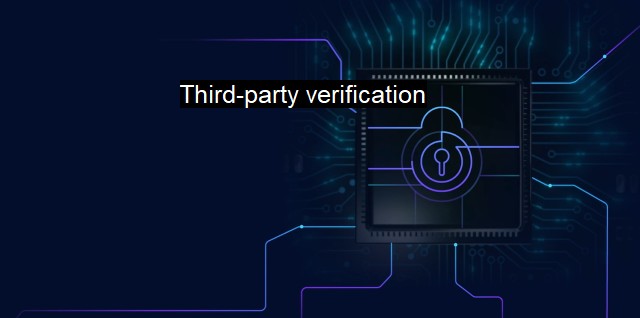What is Third-party verification?
Ensuring Trust and Reliability: The Importance of Third-Party Verification for Cybersecurity and Antivirus Products
Third-party verification refers to a mechanism that ensures that all necessary security measures have been employed by utilizing the expertise of an independent third-party. This independent entity evaluates the safety protocols implemented by a company and provides validation that the practices adhere to set industry standards and regulatory requirements.The world of cybersecurity has become more complex in recent years and criminal activities, such as identity theft, ransomware attacks and data breaches, have become more frequent. An organization’s IT infrastructure has become its back-bone, and it contains sensitive data that needs to be protected. Now, more than ever, it is critical that companies take all necessary steps to ensure their digital presence is secure and that they afford their customers' data the same level of protection. This is where third-party verification plays a central role as it helps to identify vulnerabilities and threats that might otherwise go unnoticed.
One advantage of third-party verification is objectivity. Internal security audits are susceptible to bias since they are carried out by those who implemented or are familiar with the systems in place. An external entity, on the other hand, can approach the evaluation without pre-set assumptions, thus examining the systems from fresh perspectives. A third-party auditor’s sole purpose is to locate and fortify weaknesses, which means they have no vested interest in the system apart from ensuring its security, lending a higher degree of credibility to their assessment.
On the other hand, third-party verification serves as a comprehensive assessment of a company's cybersecurity landscape. It is essential to understand that threats to computer systems are not static but are continuously changing and evolving. Third-party verification uses systematic approaches and varied methodologies to detect a multitude of threats, including those still unknown to the sphere. Utilizing antivirus tools, intrusion testing, and firewall efficacy evaluation, a third-party auditor can present a holistic view of an organization's cybersecurity stance.
Besides, third-party verification in cybersecurity fosters trust between a company and its stakeholders. For instance, when customer data is involved, companies need to be able to assure their customers that their sensitive information is safe and protected against unauthorized access, data corruption, and cyber theft. Validation from a third-party that the required cybersecurity measures are in place and working efficiently provides this assurance.
Another pivotal role of third-party verification lies within the regulatory landscape. In sectors like finance, healthcare, and insurance, where the handling of sensitive data is routine, companies are required to comply with certain security standards like General Data Protection Regulation (GDPR), Payment Card Industry Data Security Standard (PCI DSS), and Health Insurance Portability and Accountability Act (HIPAA). Failure to meet these standards can result in hefty fines and loss of trust and reputation. An independent third-party auditor is often relied upon to ensure compliance with such regulations.
Third-party verification determines the reliability of the antivirus solutions used by firms. All commercial antivirus solutions make claims about their capabilities. Third-party testing labs leverage sophisticated methodologies to scrutinize these claims. They conduct detailed analysis of how effectively the antivirus identifies and combats various malware types, while assessing the impact on system performance. This rigorous examination helps determine an antivirus's actual capabilities, rather than relying purely on manufacturer claims.
Third-party verification serves as an independent and reliable means of establishing the strength, adequacy, and reliability of a company’s cybersecurity measures. It plays an integral role in fostering trust, ensuring compliance, identifying vulnerabilities, authenticating antivirus claims, and ultimately safeguarding valuable digital assets against escalating security threats.

Third-party verification FAQs
What is third-party verification?
Third-party verification refers to the process of having an independent and unbiased party check and validate a company's products or services. This process is commonly used in the cybersecurity and antivirus industries to ensure that the software being offered is reliable and secure.Why is third-party verification important in cybersecurity and antivirus?
Third-party verification is important in cybersecurity and antivirus because it provides an objective assessment of a product's effectiveness in protecting against threats. It ensures that the product meets industry standards and is free from vulnerabilities that could be exploited by cybercriminals.Who conducts third-party verification in the cybersecurity and antivirus industries?
Third-party verification is typically conducted by independent security firms or organizations that specialize in testing and evaluating software products. These firms have the necessary expertise and tools to conduct comprehensive assessments of software products and identify any weaknesses or vulnerabilities.What are the benefits of third-party verification for consumers?
Third-party verification provides consumers with the assurance that a product has been thoroughly tested and is effective in protecting against cyber threats. It also helps consumers to make informed decisions about which products to use and trust. Additionally, third-party verification can help to build trust between consumers and software vendors, leading to increased customer satisfaction and loyalty.| | A | | | B | | | C | | | D | | | E | | | F | | | G | | | H | | | I | | | J | | | K | | | L | | | M | |
| | N | | | O | | | P | | | Q | | | R | | | S | | | T | | | U | | | V | | | W | | | X | | | Y | | | Z | |
| | 1 | | | 2 | | | 3 | | | 4 | | | 7 | | | 8 | | |||||||